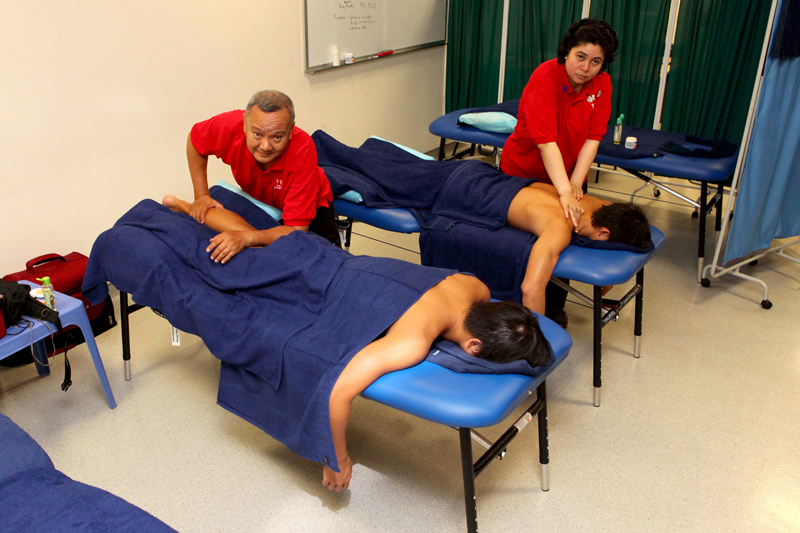Athlete recovery: can foam rolling match massage?

It’s not just what you can do in training that counts, it’s also what you can recover from. In the past, the emphasis has been almost entirely on what to do in training. Discussion focused on volumes, intensities, exercises, and modes of training. Over time however, the importance of recovery has become more widely recognized, with an emphasis on sleep and nutrition. And beyond the recovery basics, external modes of recovery such as massage, icing, and manual therapy have fallen under the spotlight popular.
What is manual therapy?
Manual therapy consists of the specific manipulation of muscles, joints, and other soft tissues to create a specific effect. While manual therapy was originally perceived as an activity that could make you ‘feel good’, it soon was discovered that manual therapy could be used to enhance recovery of the body following difficult training.
Manual therapy is thought to promote a number of positive benefits. These include increases in flexibility, increases in dynamic balance, and increases in muscular strength. While scientific validation of this therapy strategy took many years to emerge (and it still somewhat controversial), athletes were convinced. Regular manual therapy is a component of many elite athletes’ recovery programs, and different types of manual therapy are an integral part of the injury prevention and injury rehabilitation toolbox used by physiotherapists of all types.
The downside however is that regular manual therapy is an expensive luxury that most non-professional athletes are not able to afford. Fortunately, another option emerged with the introduction of the foam roller. The foam roller allowed any individual to get access to manual therapy. They just had to do it themselves! With a one-time purchase, anyone with a little patience to learn the appropriate techniques could discover how to apply basic manual therapy themselves. For many, this was a terrific introduction that made a significant difference in helping individuals feel better.
Foam rolling questions
After the initial foam rolling enthusiasm died down, many began to question the value of self-therapy, and there was a bit of a backlash against foam rollers. Can foam rolling really substitute for manual therapy? Can athletes expect similar outcomes when using foam rolling? Does foam rolling even work? What is best practice for an athlete who is looking for some kind of manual therapy, but doesn’t have access to a qualified manual therapist, due to geographical constraints or a lack of time or money? These are questions without concrete answers.
Fortunately, a group of Spanish researchers decided to begin the process of providing answers to these questions. They wanted to know how foam rolling stacked up against manual therapy when performed after an intense exercise session in terms of enhancing strength, flexibility, and dynamic balance. Is foam rolling worth the effort? Let’s find out!
You need to be logged in to continue reading.
Please register for limited access or take a 30-day risk-free trial of Sports Performance Bulletin to experience the full benefits of a subscription. TAKE A RISK-FREE TRIAL
TAKE A RISK-FREE TRIAL
Newsletter Sign Up
Testimonials
Dr. Alexandra Fandetti-Robin, Back & Body Chiropractic
Elspeth Cowell MSCh DpodM SRCh HCPC reg
William Hunter, Nuffield Health
Newsletter Sign Up
Coaches Testimonials
Dr. Alexandra Fandetti-Robin, Back & Body Chiropractic
Elspeth Cowell MSCh DpodM SRCh HCPC reg
William Hunter, Nuffield Health
Keep up with latest sports science research and apply it to maximize performance
Today you have the chance to join a group of athletes, and sports coaches/trainers who all have something special in common...
They use the latest research to improve performance for themselves and their clients - both athletes and sports teams - with help from global specialists in the fields of sports science, sports medicine and sports psychology.
They do this by reading Sports Performance Bulletin, an easy-to-digest but serious-minded journal dedicated to high performance sports. SPB offers a wealth of information and insight into the latest research, in an easily-accessible and understood format, along with a wealth of practical recommendations.
*includes 3 coaching manuals
Get Inspired
All the latest techniques and approaches
Sports Performance Bulletin helps dedicated endurance athletes improve their performance. Sense-checking the latest sports science research, and sourcing evidence and case studies to support findings, Sports Performance Bulletin turns proven insights into easily digestible practical advice. Supporting athletes, coaches and professionals who wish to ensure their guidance and programmes are kept right up to date and based on credible science.








